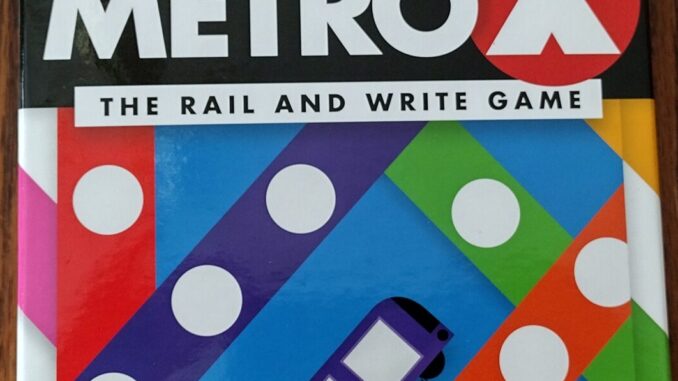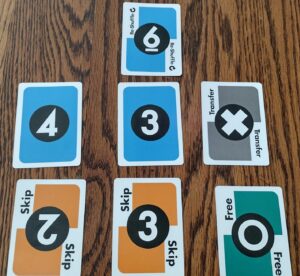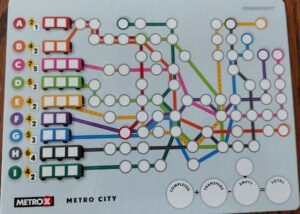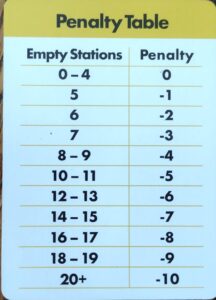
Grab your metro card, we’re off to check out another game while riding the subway. Today we’re looking at Metro-X by Gamewright.
Gameplay- A

The basic gameplay of Metro-X is simple and straightforward. It’s a riff on “Roll and Write” the designers dub “Rail and Write.” Each player has an identical board that represents a fictional subway system with multiple colored lines. Each line has several stops along its path. If you fill in all of them, you score points for that line. If you’re the first to complete a line, you get more points than anyone else who completes it on a later turn.
Each turn a card will be revealed. Most of the cards have a number from 2 to 6, that indicate how many stops along a subway line you can fill in. When you move along a line, you must start at the first open space from the start point. No skipping around. Each line has a subway car at the beginning point with a number of boxes from 2 to 4. When you move along a line, you will need to fill in one of the boxes on the train car. This limits how many times you can advance along any particular line. Fill in all the boxes on the train car before you’ve visited all the stops and you won’t be able to complete (and score) that line.

So far, everything seems simple enough. Fill in circles based on the number on a card. The trick comes into play with how the lines interact. All of the lines intersect each other at various locations on your board. Once a stop is marked, it’s marked for all lines that cross there. When you are filling out new stops, if you come to a stop that has already been marked, you have to stop, even if you can go further. This can often result in some lines have several one stop gaps.
There are a few ways to get around this. Some of the cards are Skip cards. When those are revealed, and you are moving along a line, you can skip over already marked locations. There is also a single Free Space card in the deck. This card allows you to fill in any space on the board without needing to mark off one of your train slots. Very handy for filling in a gap or finishing off a line that doesn’t have any slots left.
The final type of card in the deck is a Transfer card. When you draw one of those, you fill out a train slot just line a number but only mark one space on that line. You then score two points for that space based on the number of lines that cross that stop. If there’s only one line, you get two points.  This can get up as high as ten points. Transfers are a mixed bag. On one hand, if you can put them in those big cross points, you can get a bunch of points (for example, the maximum a line can be worth is 7 but the best transfer is worth 10). But, it takes up a train route slot but only fills in one of the stops, which can make completing that route difficult.
This can get up as high as ten points. Transfers are a mixed bag. On one hand, if you can put them in those big cross points, you can get a bunch of points (for example, the maximum a line can be worth is 7 but the best transfer is worth 10). But, it takes up a train route slot but only fills in one of the stops, which can make completing that route difficult.
The game ends when the last train box has been filled. Players then add up their scores for completed lines, points they got from Transfer cards and then subtracts a number of points for unfilled stops on the board. The player with the most points wins.
Production- A+
The game comes with dry erase boards with two printed maps on them. This gives you two different maps to use to keep the game interesting. The dry erase feature is a great one. This avoids needing to mess with any fiddly tokens and is not a waste of a bunch of paper.
Theme- A
This is the type of game where the theme is an easily tacked on feature. You’re drawing a card and deciding on a box to fill out. You could theme that a number of different ways. However, they make good use of their theme to support the mechanics. Primarily, the board does a great job of looking like a metro map. This sells the riding the rails theme.
Expansions- TBD
Not that kind of game.
Conclusion- A
Like all X and Write style games, the key to the game is figuring out what to fill out. Naturally, this often results in picking from a number of bad choices. This can be frustrating for a player. But that is the core of the game mechanic so it generally doesn’t ruin the experience. If that tough decision aspect aggravates you, these games aren’t for you.
This is a competitive game but it is not adversarial. The only impact you have on other players is who manages to complete a route first and score the higher value for it. But that’s just score which you are competing over. You can’t negatively affect another players choices which makes this a good game for a friendly competition game.
Overall, I’d say this is a fun game for a group to play to kill some time.

Wayne Basta
Latest posts by Wayne Basta (see all)
- X-Wing Tier List – Rebels - May 10, 2023

